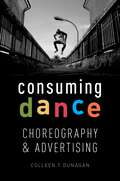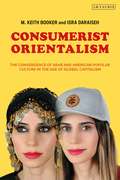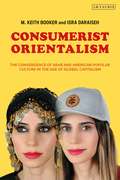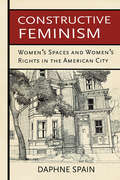- Table View
- List View
Consuming Dance: Choreography and Advertising
by Colleen T. DunaganDance in TV advertisements has long been familiar to Americans as a silhouette dancing against a colored screen, exhibiting moves from air guitar to breakdance tricks, all in service of selling the latest Apple product. But as author Colleen T. Dunagan shows in Consuming Dance, the advertising industry used dance to market items long before iPods. In this book, Dunagan lays out a comprehensive history and analysis of dance commercials to demonstrate the ways in which the form articulates with, informs, and reflects U.S. culture. In doing so, she examines dance commercials as cultural products, looking at the ways in which dance engages with television, film, and advertising in the production of cultural meaning. Throughout the book, Dunagan interweaves semiotics, choreographic analysis, cultural studies, and critical theory in an examination of contemporary dance commercials while placing the analysis within a historical context. She draws upon connections between individual dance-commercials and the discursive and production histories to provide a thorough look into brand identity and advertising's role in constructing social identities.
Consuming Cultural Hegemony: Bollywood in Bangladesh
by Harisur RahmanThis book examines the circulation and viewership of Bollywood films and filmi modernity in Bangladesh. The writer poses a number of fundamental questions: what it means to be a Bangladeshi in South Asia, what it means to be a Bangladeshi fan of Hindi film, and how popular film reflects power relations in South Asia. The writer argues that partition has resulted in India holding hegemonic power over all of South Asia’s nation-states at the political, economic, and military levels–a situation that has made possible its cultural hegemony. The book draws on relevant literature from anthropology, sociology, film, media, communication, and cultural studies to explore the concepts of hegemony, circulation, viewership, cultural taste, and South Asian cultural history and politics.
Consuming Architecture: On the occupation, appropriation and interpretation of buildings
by Daniel Maudlin Marcel VellingaProjecting forward in time from the processes of design and construction that are so often the focus of architectural discourse, Consuming Architecture examines the variety of ways in which buildings are consumed after they have been produced, focusing in particular on processes of occupation, appropriation and interpretation. Drawing on contributions by architects, historians, anthropologists, literary critics, artists, film-makers, photographers and journalists, it shows how the consumption of architecture is a dynamic and creative act that involves the creation and negotiation of meanings and values by different stakeholders and that can be expressed in different voices. In so doing, it challenges ideas of what constitutes architecture, architectural discourse and architectural education, how we understand and think about it, and who can claim ownership of it. Consuming Architecture is aimed at students in architectural education and will also be of interest to students and researchers from disciplines that deal with architecture in terms of consumption and material culture.
Consuming Architecture: On the occupation, appropriation and interpretation of buildings
by Daniel Maudlin Marcel VellingaProjecting forward in time from the processes of design and construction that are so often the focus of architectural discourse, Consuming Architecture examines the variety of ways in which buildings are consumed after they have been produced, focusing in particular on processes of occupation, appropriation and interpretation. Drawing on contributions by architects, historians, anthropologists, literary critics, artists, film-makers, photographers and journalists, it shows how the consumption of architecture is a dynamic and creative act that involves the creation and negotiation of meanings and values by different stakeholders and that can be expressed in different voices. In so doing, it challenges ideas of what constitutes architecture, architectural discourse and architectural education, how we understand and think about it, and who can claim ownership of it. Consuming Architecture is aimed at students in architectural education and will also be of interest to students and researchers from disciplines that deal with architecture in terms of consumption and material culture.
Consumerist Orientalism: The Convergence of Arab and American Popular Culture in the Age of Global Capitalism
by M. Keith Booker Isra DaraisehIn a postmodern world of globalised capital, how does the concept of Orientalism inform understandings of cultural exchange? In this detailed and wide-ranging examination, Arab popular culture is explored in its relation to American culture and capitalism. Offering new insights on Edward Said's longstanding theoretical lens, Consumerist Orientalism presents an updated conceptual framework through which to understand the intercultural relationship between East and West, exploring a wide range of cultural production; from an Oscar-nominated Jordanian film to Turkish-Arab soap operas and Arab-diaspora rap. Drawing on key contemporary critical thinkers and in-depth cultural analysis, the relationship between capitalism, postmodernism and Orientalism is explored with fresh insights, making this essential reading for students of Middle Eastern culture, globalisation and postcolonial studies.
Consumerist Orientalism: The Convergence of Arab and American Popular Culture in the Age of Global Capitalism
by M. Keith Booker Isra DaraisehIn a postmodern world of globalised capital, how does the concept of Orientalism inform understandings of cultural exchange? In this detailed and wide-ranging examination, Arab popular culture is explored in its relation to American culture and capitalism. Offering new insights on Edward Said's longstanding theoretical lens, Consumerist Orientalism presents an updated conceptual framework through which to understand the intercultural relationship between East and West, exploring a wide range of cultural production; from an Oscar-nominated Jordanian film to Turkish-Arab soap operas and Arab-diaspora rap. Drawing on key contemporary critical thinkers and in-depth cultural analysis, the relationship between capitalism, postmodernism and Orientalism is explored with fresh insights, making this essential reading for students of Middle Eastern culture, globalisation and postcolonial studies.
Consumerist Encounters: Flirting with Things and Images
by Sreedeep BhattacharyaEconomic liberalization and globalization in India in the early 1990s resulted in a whirlwind of consumerist activities. New material and visual temptations swamped the markets. Expanding field of commodification infiltrated consumer minds through media imageries. New objects of desire aroused inhibited cravings. This engendered an accelerated and intensified relationship with things and images that permeate our everyday lives. Consumerist Encounters elucidates how our all-consuming relationship with objects and their representations have transformed rapidly over the last few decades in contemporary urban India. It argues that ephemerality, frivolousness, and multiplicity of choice regulate our flirtatious encounters with commodities and their images as we restlessly use, exhaust, dispose, and move on. Such a trend is illustrated by examining a plethora of commodity-centric phenomena such as exclusion through apparel, eroticization of body images, population of the T-shirt surface with graphics and text, rise of business process outsourcing, instantaneous seeing and sharing of images, and rejection of material goods in junkyards and ruins. These explorations collectively shed light on the constant negotiation of our identities, statuses, and mobilities in the image-saturated commodity landscape.
Consumer Product Innovation and Sustainable Design: The Evolution and Impacts of Successful Products
by Robin RoyConsumer Product Innovation and Sustainable Design follows the innovation and evolution of consumer products from vacuum cleaners to mobile phones from their original inventions to the present day. It discusses how environmental concerns and legislation have influenced their design and the profound effects these products have had on society and culture. This book also uses the lessons from the successes and failures of examples of these consumer products to draw out practical guidelines for designers, engineers, marketers and managers on how to become more effective at product development, innovation and designing for environmental sustainability.
Consumer Product Innovation and Sustainable Design: The Evolution and Impacts of Successful Products
by Robin RoyConsumer Product Innovation and Sustainable Design follows the innovation and evolution of consumer products from vacuum cleaners to mobile phones from their original inventions to the present day. It discusses how environmental concerns and legislation have influenced their design and the profound effects these products have had on society and culture. This book also uses the lessons from the successes and failures of examples of these consumer products to draw out practical guidelines for designers, engineers, marketers and managers on how to become more effective at product development, innovation and designing for environmental sustainability.
Consumer Packaging Strategy: Localisation in Asian Markets (Routledge Advances in Management and Business Studies)
by Huda Khan Richard Lee Polymeros ChrysochouThe consumer packaged goods (CPG) industry is dominated by major Western brands. The dominance of such major brands extends to Asian burgeoning markets. These conglomerates often rely on packaging as a strategic tool to entice Asian consumers. This book illustrates how packaging as a marketing tool is more than simply changing the label or translating the brand into vernacular language. It examines how different packaging elements (e.g. information, imagery, packaging type) can help to communicate product values to Asian consumers. Drawing upon rich knowledge of the Asian CPG markets with extensive findings from fieldworks in the key Asian markets, this book explains how Western brands are localising their packaging design in Asian markets. It provides invaluable insight into how major Western CPG brands have relied heavily on their packaging strategies to compete not only against domestic brands but also against other foreign brands. The book includes in-depth interviews with brand managers of several major Western CPG brands and retailers, and sheds light on emerging trends of CPG packaging in Asia.
Consumer Packaging Strategy: Localisation in Asian Markets (Routledge Advances in Management and Business Studies)
by Huda Khan Richard Lee Polymeros ChrysochouThe consumer packaged goods (CPG) industry is dominated by major Western brands. The dominance of such major brands extends to Asian burgeoning markets. These conglomerates often rely on packaging as a strategic tool to entice Asian consumers. This book illustrates how packaging as a marketing tool is more than simply changing the label or translating the brand into vernacular language. It examines how different packaging elements (e.g. information, imagery, packaging type) can help to communicate product values to Asian consumers. Drawing upon rich knowledge of the Asian CPG markets with extensive findings from fieldworks in the key Asian markets, this book explains how Western brands are localising their packaging design in Asian markets. It provides invaluable insight into how major Western CPG brands have relied heavily on their packaging strategies to compete not only against domestic brands but also against other foreign brands. The book includes in-depth interviews with brand managers of several major Western CPG brands and retailers, and sheds light on emerging trends of CPG packaging in Asia.
Consumer Depth Cameras for Computer Vision: Research Topics and Applications (Advances in Computer Vision and Pattern Recognition)
by Andrea Fossati, Juergen Gall, Helmut Grabner, Xiaofeng Ren and Kurt KonoligeThe potential of consumer depth cameras extends well beyond entertainment and gaming, to real-world commercial applications. This authoritative text reviews the scope and impact of this rapidly growing field, describing the most promising Kinect-based research activities, discussing significant current challenges, and showcasing exciting applications. Features: presents contributions from an international selection of preeminent authorities in their fields, from both academic and corporate research; addresses the classic problem of multi-view geometry of how to correlate images from different viewpoints to simultaneously estimate camera poses and world points; examines human pose estimation using video-rate depth images for gaming, motion capture, 3D human body scans, and hand pose recognition for sign language parsing; provides a review of approaches to various recognition problems, including category and instance learning of objects, and human activity recognition; with a Foreword by Dr. Jamie Shotton.
Consumer Culture Reborn: The Cultural Politics of Consumption
by Martyn J. LeeFirst published in 1993. Routledge is an imprint of Taylor & Francis, an informa company.
Consumer Culture Reborn: The Cultural Politics of Consumption
by Martyn J. LeeFirst published in 1993. Routledge is an imprint of Taylor & Francis, an informa company.
Consumer Behavior in Practice: Strategic Insights for the Modern Marketer
by Eugene Y. ChanAimed at marketing students and practitioners, this book places less emphasis on theory but, instead, helps readers to understand why their customers are acting in a certain way or why their marketing activities or initiatives are not (or are) working out.The text examines the relevance of consumer behavior in such marketing topics as advertising and pricing, with topical chapters such as the sharing economy, luxury consumer behavior, and the ideological consumer. Each chapter includes boxes that highlight theory in greater depth; show how the concepts discuss “work” in actual practice; and the relevance of digital and social media marketing.This book will prove useful to those looking for a greater understanding of how consumer behavior provides greater insight about marketing activities.
Consumed: A Sister's Story
by Arifa Akbar'If her moving, engrossing, elegantly written memoir does not win prizes, there really is no justice in the literary world.' Lucy Atkins, Sunday TimesAll happy families are alike; each unhappy family is unhappy in its own way.When Arifa Akbar discovered that her sister had fallen seriously ill, she assumed there would be a brief spell in hospital and then she'd be home. This was not to be. It was not until the day before she died that the family discovered she was suffering from tuberculosis. Consumed is a story of sisterhood, grief, the redemptive power of art and the strange mythologies that surround tuberculosis. It takes us from Keats's deathbed and the tubercular women of opera to the resurgence of TB in modern Britain today. Arifa travels to Rome to haunt the places Keats and her sister had explored, to her grandparent's house in Pakistan, to her sister's bedside at the Royal Free Hospital in Hampstead and back to a London of the seventies when her family first arrived, poor, homeless and hungry. Consumed is an eloquent and moving excavation of a family's secrets and a sister's detective story to understand her sibling.
Consumed: The need for collective change; colonialism, climate change & consumerism
by Aja Barber'Consumed takes us through the hideously complex topic of fashion and sustainability, from its knotty colonial roots to what everyday people can do to uproot those systems, today.' - Yassmin Abdel-Magied 'SUCH integrity. Aja is no bullsh*t.' - Florence Given Aja Barber wants change. In the 'learning' first half of the book, she will expose you to the endemic injustices in our consumer industries and the uncomfortable history of the textile industry; one which brokered slavery, racism and today's wealth inequality. And how these oppressive systems have bled into the fashion industry and its lack of diversity and equality. She will also reveal how we spend our money and whose pockets it goes into and whose it doesn't (clue: the people who do the actual work) and will tell her story of how she came to learn the truth.In the second 'unlearning' half of the book, she will help you to understand the uncomfortable truth behind why you consume the way you do. She asks you to confront the sense of lack you have, the feeling that you are never quite enough and the reasons why you fill the aching void with consumption rather than compassion. And she makes you challenge this power disparity, and take back ownership of it. The less you buy into the consumer culture the more power you have.CONSUMED will teach you how to be a citizen not a consumer. 'An absolute must-read for any person who wears clothes.' - Orsola de Castro 'A hugely compelling exploration of a culture of exploitation and how, together, we can end it.' - Gina Martin 'Barber's isn't just a voice we should listen to - it is a voice we MUST listen to.' - Clementine Ford 'If you buy one book about sustainable fashion, make it this one. Consumed is an urgent call to action to demand a fashion system that is actually fair for both people and planet, not just Big Fashion billionaires. I adore Aja and I love this brilliant book.' - Venetia La Manna
Constructivist design for 1928 Calendar Cover (UEB uncontracted)
by RnibThis is an image of a cover for a calendar designed by Hungarian artist Karl Dukai. There is a locator dot shown, which will be at the top left of the page when the image is the correct way up. The image shows a highly stylised industrial landscape designed with simple geometric shapes, and the year and title of the calendar. Two colours are used: black and red ochre on a pale background. In the tactile version of the design, black is shown as a thick, horizontal lined texture and red ochre as a light dotted texture. At the top centre of the page are three triangles representing smoke. They point down to three tall shapes which are the chimneys of a factory. To the right of these is the print number 1, and down the page is the number 9, the first numbers of the year 1928. To the left of the chimneys are two objects constructed from sections of circles; maybe symbolising parts of machinery. Further down the page is a thick line going diagonally up the page from left to right. This is the factory's roof. Down the page again are small rectangles in groups of two and three representing the factory's windows. On the right of the factory are the print numbers 2 with 8 down the page. Stretching across the bottom of the design is the title Népszava Naptár (People's Voice Calendar) in upper case print letters. It was published by the socialist Hungarian newspaper Népszava. The sparse geometric design of the cover is in the style of the Russian constructivists who considered art should be used for social purposes and often celebrated technology and industry.
Constructivist design for 1928 Calendar Cover (UEB uncontracted)
by RnibThis is an image of a cover for a calendar designed by Hungarian artist Karl Dukai. There is a locator dot shown, which will be at the top left of the page when the image is the correct way up. The image shows a highly stylised industrial landscape designed with simple geometric shapes, and the year and title of the calendar. Two colours are used: black and red ochre on a pale background. In the tactile version of the design, black is shown as a thick, horizontal lined texture and red ochre as a light dotted texture. At the top centre of the page are three triangles representing smoke. They point down to three tall shapes which are the chimneys of a factory. To the right of these is the print number 1, and down the page is the number 9, the first numbers of the year 1928. To the left of the chimneys are two objects constructed from sections of circles; maybe symbolising parts of machinery. Further down the page is a thick line going diagonally up the page from left to right. This is the factory’s roof. Down the page again are small rectangles in groups of two and three representing the factories windows. On the right of the factory are the print numbers 2 with 8 down the page. Stretching across the bottom of the design is the title ‘Nepszava Naptair’ (Peoples Voice Calendar) in upper case print letters. It was published by the socialist Hungarian newspaper Nepszava. The sparse geometric design of the cover is in the style of the Russian constructivists who considered art should be used for social purposes and often celebrated technology and industry.
Constructivist design for 1928 Calendar Cover (UEB contracted)
by RnibThis is an image of a cover for a calendar designed by Hungarian artist Karl Dukai. There is a locator dot shown, which will be at the top left of the page when the image is the correct way up. The image shows a highly stylised industrial landscape designed with simple geometric shapes, and the year and title of the calendar. Two colours are used: black and red ochre on a pale background. In the tactile version of the design, black is shown as a thick, horizontal lined texture and red ochre as a light dotted texture. At the top centre of the page are three triangles representing smoke. They point down to three tall shapes which are the chimneys of a factory. To the right of these is the print number 1, and down the page is the number 9, the first numbers of the year 1928. To the left of the chimneys are two objects constructed from sections of circles; maybe symbolising parts of machinery. Further down the page is a thick line going diagonally up the page from left to right. This is the factory's roof. Down the page again are small rectangles in groups of two and three representing the factory's windows. On the right of the factory are the print numbers 2 with 8 down the page. Stretching across the bottom of the design is the title Népszava Naptár (People's Voice Calendar) in upper case print letters. It was published by the socialist Hungarian newspaper Népszava. The sparse geometric design of the cover is in the style of the Russian constructivists who considered art should be used for social purposes and often celebrated technology and industry.
Constructivist design for 1928 Calendar Cover (UEB contracted)
by RnibThis is an image of a cover for a calendar designed by Hungarian artist Karl Dukai. There is a locator dot shown, which will be at the top left of the page when the image is the correct way up. The image shows a highly stylised industrial landscape designed with simple geometric shapes, and the year and title of the calendar. Two colours are used: black and red ochre on a pale background. In the tactile version of the design, black is shown as a thick, horizontal lined texture and red ochre as a light dotted texture. At the top centre of the page are three triangles representing smoke. They point down to three tall shapes which are the chimneys of a factory. To the right of these is the print number 1, and down the page is the number 9, the first numbers of the year 1928. To the left of the chimneys are two objects constructed from sections of circles; maybe symbolising parts of machinery. Further down the page is a thick line going diagonally up the page from left to right. This is the factory’s roof. Down the page again are small rectangles in groups of two and three representing the factories windows. On the right of the factory are the print numbers 2 with 8 down the page. Stretching across the bottom of the design is the title ‘Nepszava Naptair’ (Peoples Voice Calendar) in upper case print letters. It was published by the socialist Hungarian newspaper Nepszava. The sparse geometric design of the cover is in the style of the Russian constructivists who considered art should be used for social purposes and often celebrated technology and industry.
Constructivist design for 1928 Calendar Cover (large print)
by RnibThis is an image of a cover for a calendar designed by Hungarian artist Karl Dukai. There is a locator dot shown, which will be at the top left of the page when the image is the correct way up. The image shows a highly stylised industrial landscape designed with simple geometric shapes, and the year and title of the calendar. Two colours are used: black and red ochre on a pale background. In the tactile version of the design, black is shown as a thick, horizontal lined texture and red ochre as a light dotted texture. At the top centre of the page are three triangles representing smoke. They point down to three tall shapes which are the chimneys of a factory. To the right of these is the print number 1, and down the page is the number 9, the first numbers of the year 1928. To the left of the chimneys are two objects constructed from sections of circles; maybe symbolising parts of machinery. Further down the page is a thick line going diagonally up the page from left to right. This is the factory's roof. Down the page again are small rectangles in groups of two and three representing the factory's windows. On the right of the factory are the print numbers 2 with 8 down the page. Stretching across the bottom of the design is the title Népszava Naptár (People's Voice Calendar) in upper case print letters. It was published by the socialist Hungarian newspaper Népszava. The sparse geometric design of the cover is in the style of the Russian constructivists who considered art should be used for social purposes and often celebrated technology and industry.
Constructivist design for 1928 Calendar Cover (large print)
by RnibThis is an image of a cover for a calendar designed by Hungarian artist Karl Dukai. There is a locator dot shown, which will be at the top left of the page when the image is the correct way up. The image shows a highly stylised industrial landscape designed with simple geometric shapes, and the year and title of the calendar. Two colours are used: black and red ochre on a pale background. In the tactile version of the design, black is shown as a thick, horizontal lined texture and red ochre as a light dotted texture. At the top centre of the page are three triangles representing smoke. They point down to three tall shapes which are the chimneys of a factory. To the right of these is the print number 1, and down the page is the number 9, the first numbers of the year 1928. To the left of the chimneys are two objects constructed from sections of circles; maybe symbolising parts of machinery. Further down the page is a thick line going diagonally up the page from left to right. This is the factory’s roof. Down the page again are small rectangles in groups of two and three representing the factories windows. On the right of the factory are the print numbers 2 with 8 down the page. Stretching across the bottom of the design is the title ‘Nepszava Naptair’ (Peoples Voice Calendar) in upper case print letters. It was published by the socialist Hungarian newspaper Nepszava. The sparse geometric design of the cover is in the style of the Russian constructivists who considered art should be used for social purposes and often celebrated technology and industry.
Constructive Feminism: Women's Spaces and Women's Rights in the American City
by Daphne SpainIn Constructive Feminism, Daphne Spain examines the deliberate and unintended spatial consequences of feminism’s second wave, a social movement dedicated to reconfiguring power relations between women and men. Placing the women’s movement of the 1970s in the context of other social movements that have changed the use of urban space, Spain argues that reform feminists used the legal system to end the mandatory segregation of women and men in public institutions, while radical activists created small-scale places that gave women the confidence to claim their rights to the public sphere. Women’s centers, bookstores, health clinics, and domestic violence shelters established feminist places for women’s liberation in Boston, Los Angeles, and many other cities. Unable to afford their own buildings, radicals adapted existing structures to serve as women’s centers that fostered autonomy, health clinics that promoted reproductive rights, bookstores that connected women to feminist thought, and domestic violence shelters that protected their bodily integrity. Legal equal opportunity reforms and daily practices of liberation enhanced women’s choices in education and occupations. Once the majority of wives and mothers had joined the labor force, by the mid-1980s, new buildings began to emerge that substituted for the unpaid domestic tasks once performed in the home. Fast food franchises, childcare facilities, adult day centers, and hospices were among the inadvertent spatial consequences of the second wave.
Constructions of Female Homoeroticism in Early Modern Drama (Early Modern Cultural Studies 1500–1700)
by D. WalenThis book explores representations of love and desire between female characters in nearly seventy plays written between 1580 and 1660. The work argues that playwrights of late sixteenth- and early seventeenth-century England recognized and constructed richly diverse tropes of female homoerotic desire. Writers place female characters in erotic situations with other female characters in playful scenarios of mistaken identity, in anxious moments of amorous intrigue, in predatory situations and in enthusiastic, utopian representations of romantic love. These plays indicate an awareness of female homoeroticism in early modern England and belie statements that literary evidence of homosexuality was concerned primarily with men.















